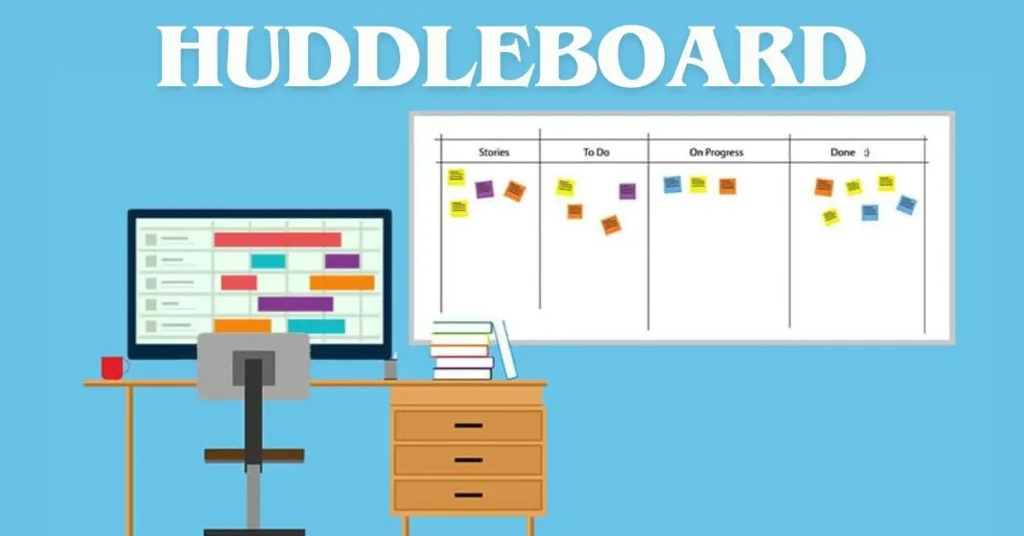Have you ever felt like your team meetings are dragging on without producing concrete results? Or maybe you’ve struggled with keeping everyone on the same page with project updates and deadlines? If so, a huddleboard might be the game-changer you need. In this comprehensive guide, we’ll explore what a huddleboard is, how it can boost team productivity, and tips on implementing it effectively in your workspace.
What is a Huddleboard?
A huddleboard is a visual management tool designed to facilitate quick, focused team meetings, often referred to as “huddles.” Typically, a huddleboard displays key information about ongoing projects, tasks, deadlines, and team performance metrics. By providing a clear, concise visual representation of critical data, huddleboards help teams stay aligned and on track.
These boards can be physical whiteboards with charts and sticky notes or digital versions integrated into project management software. Regardless of the format, the goal remains the same: to enhance communication, accountability, and productivity.
Types of Huddleboards:
There are various types of huddleboards, each catering to different needs. Some common ones include:
- Task Boards: These focus on tracking individual tasks and their progress. They often use columns like “To Do,” “In Progress,” and “Done.”
- Performance Boards: These display metrics and KPIs (Key Performance Indicators) to monitor team performance against targets.
- Project Boards: These provide an overview of project timelines, milestones, and deliverables, helping teams track progress and stay on schedule.
Why Use a Huddleboard?
Improved Communication:
One of the primary benefits of using a huddleboard is improved communication. By visually displaying important information, team members can quickly grasp the status of projects and tasks. This transparency reduces misunderstandings and ensures everyone is on the same page.
Enhanced Accountability:
When tasks and responsibilities are clearly outlined on a huddleboard, it becomes easier to hold team members accountable. Everyone knows who is responsible for what, which can motivate individuals to stay on top of their assignments and meet deadlines.
Streamlined Meetings:
Huddleboards are designed to make team meetings more efficient. Instead of lengthy discussions, huddles are short, focused, and to the point. Teams can quickly review the huddleboard, address any issues, and move on with their day, saving valuable time.
Implementing a Huddleboard in Your Team:
Choosing the Right Type:
The first step in implementing a huddleboard is choosing the right type for your team’s needs. Consider what you want to achieve with your huddles. If your main goal is to track task progress, a task board might be best. If you want to focus on team performance, a performance board could be more suitable.
Setting Up Your Huddleboard:
Once you’ve chosen the type, it’s time to set up your huddleboard. For a physical board, you’ll need a whiteboard, markers, sticky notes, and any other visual aids that can help display information clearly. For a digital board, explore project management tools like Trello, Asana, or Jira that offer customizable board features.
Organize the board into sections that make sense for your workflow. Common sections include:
- To Do: Tasks that need to be started.
- In Progress: Tasks currently being worked on.
- Done: Completed tasks.
- Metrics: Key performance indicators and other relevant metrics.
Regular Huddle Meetings:
Establish a routine for huddle meetings. Daily huddles are common in many agile teams, but the frequency can be adjusted based on your team’s needs. Keep these meetings short—typically no longer than 15 minutes. The focus should be on quick updates, identifying roadblocks, and planning the day’s work.
Encourage Participation:
For a huddleboard to be effective, it’s essential that all team members actively participate. Encourage everyone to update the board regularly and bring up any issues during huddles. This collective involvement ensures the board remains a valuable tool for the entire team.
Tips for Maximizing the Effectiveness of Huddleboards:
Keep It Simple:
Simplicity is key when it comes to huddleboards. Avoid clutter and only display essential information. A cluttered board can be overwhelming and counterproductive.
Update Regularly:
Ensure that the huddleboard is updated regularly. Outdated information can lead to confusion and reduce the board’s effectiveness. Assign someone to be responsible for maintaining the board or make it a shared responsibility among team members.
Use Visuals:
Visual aids like charts, graphs, and color coding can make the huddleboard more engaging and easier to understand at a glance. Use these tools to highlight critical information and track progress.
Celebrate Successes:
Use the huddleboard to recognize and celebrate team achievements. Acknowledging completed tasks and milestones can boost morale and motivate the team to continue performing well.
Real-Life Examples of Huddleboard Success:
Case Study: Marketing Team:
A marketing team at a mid-sized company struggled with keeping track of multiple campaigns and deadlines. They implemented a digital huddleboard using Trello, organizing it into sections for each campaign with tasks under “To Do,” “In Progress,” and “Done.” By holding daily huddles and updating the board regularly, they significantly improved their workflow efficiency and met their campaign deadlines more consistently.
Case Study: Software Development Team:
A software development team faced challenges with tracking progress and identifying bottlenecks. They adopted a physical huddleboard, dividing it into sections for different projects and including a performance metrics area. Daily huddles helped them quickly address issues and streamline their development process, resulting in faster delivery times and higher quality code.
Common Challenges and How to Overcome Them:
Resistance to Change:
Introducing a huddleboard can be met with resistance, especially if your team is used to traditional meeting formats. To overcome this, communicate the benefits clearly and involve the team in the setup process. Show how a huddleboard can save time and improve productivity.
Keeping the Board Updated:
A common challenge is ensuring the board is always up-to-date. Assigning responsibility to specific team members or incorporating board updates into the huddle meeting routine can help maintain accuracy.
Balancing Detail with Clarity:
Finding the right balance between providing enough detail and keeping the board simple can be tricky. Focus on including only the most crucial information and use visual aids to convey complex data succinctly.
The Future of Huddleboards:
Integration with Technology;
As technology continues to advance, huddleboards are becoming more sophisticated. Digital huddleboards integrated with project management software can offer real-time updates, automated reporting, and remote accessibility, making them even more powerful tools for teams.
Customization and Flexibility:
Future huddleboards will likely offer even greater customization and flexibility, allowing teams to tailor them precisely to their workflows and needs. This adaptability will make huddleboards an indispensable tool across various industries and team structures.
Remote and Hybrid Work Environments:
With the rise of remote and hybrid work environments, digital huddleboards are becoming increasingly important. These tools ensure that all team members, regardless of location, can stay aligned and participate in huddle meetings effectively.
Conclusion:
Huddleboards are a simple yet powerful tool for improving team communication, accountability, and productivity. By visually displaying key information and facilitating efficient meetings, huddleboards help teams stay focused and aligned on their goals. Whether you choose a physical or digital format, implementing a huddleboard can transform the way your team works and drive better results. So, if you’re ready to boost your team’s efficiency and effectiveness, consider introducing a huddleboard to your workflow today. It could be the key to unlocking your team’s full potential.







